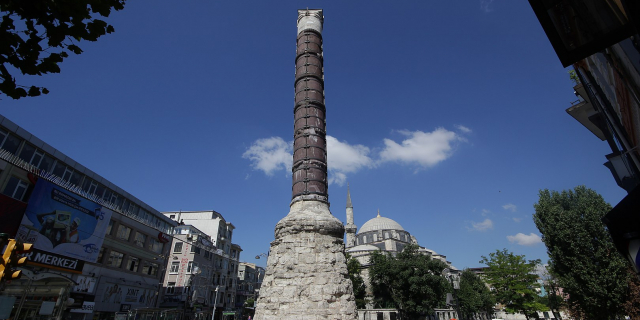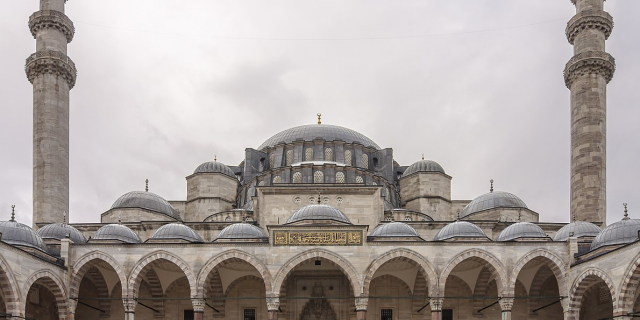Sultanahmet Camii
( Blue Mosque, Istanbul )The Blue Mosque in Istanbul, also known by its official name, the Sultan Ahmed Mosque (Turkish: Sultan Ahmet Camii), is an Ottoman-era historical imperial mosque located in Istanbul, Turkey. It was constructed between 1609 and 1617 during the rule of Ahmed I and remains a functioning mosque today. It also attracts a large number of tourists and is one of the most iconic and popular monuments of Ottoman architecture.
The mosque has a classical Ottoman layout with a central dome surrounded by four semi-domes over the prayer hall. It is fronted by a large courtyard and flanked by six minarets. On the inside, it is decorated with thousands of Iznik tiles and painted floral motifs in predominantly blue colours, which give the mosque its popular name. The mosque's külliye (religious complex) includes Ahmed's tomb, a madrasa, and several other buildings in various states of preservation.
The mosque was built next to the former Hippodrome a...Read more
The Blue Mosque in Istanbul, also known by its official name, the Sultan Ahmed Mosque (Turkish: Sultan Ahmet Camii), is an Ottoman-era historical imperial mosque located in Istanbul, Turkey. It was constructed between 1609 and 1617 during the rule of Ahmed I and remains a functioning mosque today. It also attracts a large number of tourists and is one of the most iconic and popular monuments of Ottoman architecture.
The mosque has a classical Ottoman layout with a central dome surrounded by four semi-domes over the prayer hall. It is fronted by a large courtyard and flanked by six minarets. On the inside, it is decorated with thousands of Iznik tiles and painted floral motifs in predominantly blue colours, which give the mosque its popular name. The mosque's külliye (religious complex) includes Ahmed's tomb, a madrasa, and several other buildings in various states of preservation.
The mosque was built next to the former Hippodrome and stands across from the Hagia Sophia, another popular tourist site. The Blue Mosque was included in the UNESCO World Heritage Site list in 1985 under the name of "Historic Areas of Istanbul".
 Early 18th-century depiction of Ottoman Sultan Ahmed I, by Abdulcelil Levni
Early 18th-century depiction of Ottoman Sultan Ahmed I, by Abdulcelil LevniAfter the Peace of Zsitvatorok, seen as a blow to Ottoman prestige, Sultan Ahmed I decided to build a large mosque in Istanbul in the hope of soliciting God's favour.[1] He was the first sultan to build an imperial mosque since Selim II (d. 1574), as both Murad III and Mehmed III before him had neglected to construct their own.[2][3]
The mosque was built on the southeast side of the old Byzantine Hippodrome, near the Hagia Sophia (the most important mosque of the Ottoman Empire[4][5]), a site of significant symbolic significance that allows it to dominate the city's skyline. The mosque's location was originally occupied by the Hippodrome's bleachers and its imperial box (where the emperor sat when attending events here). During excavations in the early 20th century, some of the ancient seats were discovered in the mosque's courtyard.[6] Given the mosque's location, size, and number of minarets, it is probable that Sultan Ahmed intended to create a monument that rivalled or surpassed the Hagia Sophia.[7]
Prior to construction, this site was occupied by the palaces of several Ottoman viziers, including Sokollu Mehmet Pasha and Güzel Ahmet Pasha, which required a costly expropriation process.[8][2] This, along with the fact that the empire was under economic stress, aroused the protests of the ulema (Islamic legal scholars), who argued that sultans should only fund the construction of an imperial mosque with spoils of conquest. Ahmed I had won no major victories and thus had to divert funds from the treasury for this expensive project.[8][9] The ulema went so far as to forbid Muslims from praying at the mosque.[8]
 17th-century illustration of the mosque with floor plan by French explorer Guillaume-Joseph Grelot
17th-century illustration of the mosque with floor plan by French explorer Guillaume-Joseph GrelotDespite the opposition, the sultan went ahead with the project.[8] Construction started in 1609 and completed in 1617, when the opening ceremony was held, though the year 1616 is mentioned on some of the mosque's inscriptions.[8][10][3] Ahmed I died around the same time or very soon afterwards in 1617.[11] Scholar Godfrey Goodwin notes that the last accounting reports on the mosque's construction were signed by Mustafa I, Ahmed I's successor, which suggests that Ahmed I had died before the final completion of the project.[8]
In the end, the mosque's grandeur, its luxurious decoration, and the elaborate public ceremonies that Ahmed I organized to celebrate the project appear to have swayed public opinion and overcome the initial controversy over its construction. It became one of the most popular mosques in the city.[8][9] The mosque has left a major mark on the city and has given its name to the surrounding neighbourhood, now known as Sultanahmet.[12]
RestorationsIn 1883, much of the mosque interior's painted decoration was replaced by new stenciled paintwork, some of which changed the original colour scheme.[13] A major fire in 1912 damaged or destroyed several of the outlying structures of the mosque complex, which were subsequently restored.[13]
A major restoration of the mosque took place in the 21st century. During preparatory work in 2013, it was discovered that the mosque's northwest minaret had shifted 5 centimetres (2.0 in) over time, constituting a potential threat to its structural stability. Work to reconstruct and repair the minaret was underway in 2015.[14] Comprehensive restoration work on the rest of the mosque began in 2018 and was finished in April 2023.[15][16]


































Add new comment